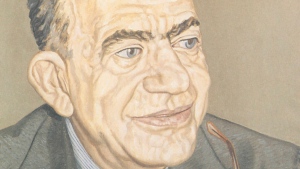We have heard before of the end of the history of art: the end both of art itself and of the scholarly study of art. Yet every time that apparently inevitable end was lamented, things nevertheless carried on, and usually in an entirely new direction. Art is produced today in undiminished volume; the academic discipline, too, survives, although with less vitality and more self-doubt than ever.
What does stand seriously in question is that conception of a universal and unified ‘history of art’ which has so long served, in different ways, both artist and art historian. Artists today often decline to participate in an ongoing history of art at all. In so doing they detach themselves from a tradition of thought which was after all initiated by an artist, Giorgio Vasari, and in many ways for artists, a tradition which provided artists with a common programme.
Art historians appeared on the scene only much later. Today they either accept a model of history which they did not themselves devise, or shun the task of establishing a new model because they cannot. Both the artist and the art historian have lost faith in a rational, teleological process of artistic history, a process to be carried out by the one and described by the other.
The perplexity arising from this situation is not necessarily to be regretted, for it can incite the artist towards new objectives and the art historian towards new questions. What seemed for so long self-evident — the commitment to the concept of all-embracing, universal ‘history’ of art — suddenly strikes us as peculiar. But to reflect on the demise of a history of art is surely not to prophesy the end of the discipline of art history. Our theme is rather the emancipation from received models of the historical presentation of art, an emancipation often achieved in practice but seldom reflected upon.
These models were for the most part varieties of stylistic history. They presented art as an autonomous system, to be evaluated by internal criteria. Human beings appeared in these histories only as artists or, if need be, as patrons.
The old art history sustained its first crisis at the hands of the avant-garde, which declared itself hostile to tradition and erected its own historical model. Afterwards two versions of the history of art coexisted, models which in their notions of ‘progress’ superficially resembled one another, but which in their actual accounts remained quite independent. Both versions preserved a faith in the existence of‘art’.
But that art no longer presented a single face: it had to be defined separately for the modern and premodern periods. Thus the historical account broke down precisely at that point where it might have engendered an alliance. This failure only revealed the extent to which both versions of the development of art had survived on the self-understanding of artists and on the arguments of critics — even as the academic discipline was desperately seeking scientific methods of its own.
The resulting confusion can generate productive energies only if its sources can be understood. For we have arrived at a point where questions about the meaning and function of art can only be discussed profitably within a larger context of past and present experience of art. Today artists include both older and modern art in the same retrospective survey, accepting both as historical phenomena, as a single problematic legacy to be confronted or consciously rejected. Likewise, the boundaries between art and the culture and people that produced it are being challenged. The interpretative tools of the old art history were refined to such an extreme that they threatened to become ends in themselves, and in those fields where the inventory of historical material was more or less complete they came to be of no practical use at all.
Crossing the boundaries between art and its social or cultural ‘background’ demands different tools and different goals of interpretation. Only an attitude of experimentation promises new answers. The connoisseur, although he retains his right to existence, can as little provide these answers as the positivist who trusts only in strictly factual information, or the specialist who jealously defends his field against dilettantes.
Today the artist joins the historian in rethinking the function of art and challenging its traditional claim to aesthetic autonomy. The dutiful artist used to study masterpieces in the Louvre; today he confronts the entire history of mankind in the British Museum, acknowledging the historicity of past cultures and in the process becoming aware of his own historicity. Anthropological interests prevail over exclusively aesthetic interests. The old antagonism between art and life has been defused, precisely because art has lost its secure frontiers against other media, visual and linguistic, and is instead understood as one of various systems of explaining and representing the world. All this opens up new possibilities but also new problems for a discipline which has always had to legitimize the isolation of its object — art — from other domains of knowledge and interpretation.
This is not to suggest that art historians are to abandon the work of art as their primary object of enquiry, nor are they to borrow from social history or other disciplines what they ought to find out for themselves. Both the role of art in human society and the nature of the individual work of art — its status as an image or its ‘figurality’ — are permanently changing: they are more than ever deserving of scholarly attention. The role of art in our own society, at least in its traditional manifestations, is as uncertain as its further course is unpredictable. We no longer march forward along the narrow path of a unidirectional history of art, but instead have been granted a kind of momentary respite, in order to re-examine the various statuses and justifications of art, both in past centuries and in the era of modernism.
Artists today are rethinking their own tasks, the surviving possibilities of such media as painting and sculpture, in light of the historical legacy of art. Art
historians are testing different models of telling the history of art, not the history of an unchallenged evolution but the history of-ever new solutions for the ever new problem of what makes an ‘image’ and what make it a convincing vision of ‘truth’ at a given moment. Finally, the problem of the status of modern over against contemporary art demands the general attention of the discipline — whether one believes in postmodernism or not.
The present situations of art history as a discipline and of the experience of art as a general phenomenon allow for no easy answers. Initiating a fresh discussion of problems common to all art historians seems more urgent than offering a programme of action. Indeed, I am avoiding nothing so much as a new or other ‘system’ of art history. On the contrary, I am convinced that today only provisional or even fragmentary assertions are possible. Moreover, I often judge from within a German background, which may seem a disadvantage for English readers, but may also confirm that even in a world of disappearing boundaries, individual positions are still rooted in and limited by particular cultural traditions. This applies even more to personal convictions about art itself, which, however, are not my topic here ...
In: The End of the History of Art? Translated by Christopher S. Wood. Chicago, 1987, pp. ix-xii.























Nenhum comentário:
Postar um comentário